How to walk Camino the Santiago, the iconic pilgrimage route in Spain, in 2025
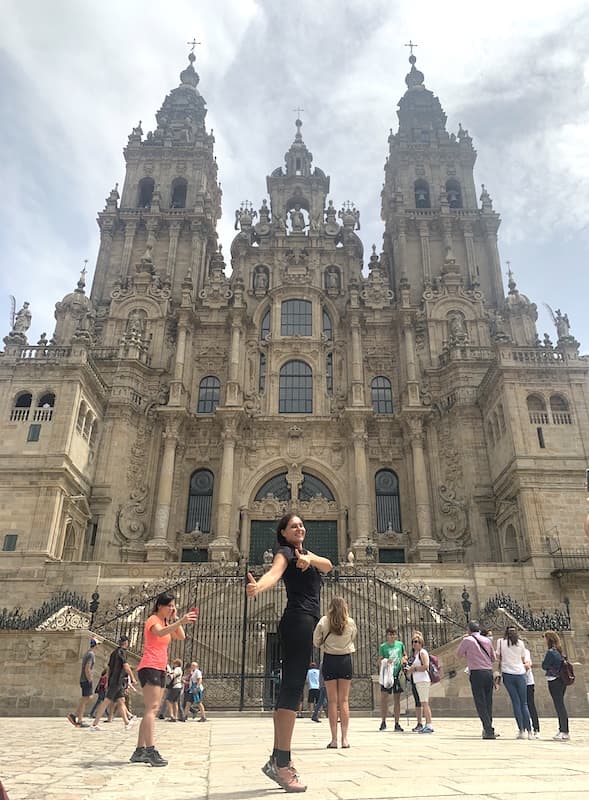
Walking Camino de Santiago is one of those must-have experiences in Spain that should be on everyone’s bucket list.
As of summer 2022, I hiked Camino del Norte, Camino de la Plata from Salamanca to Santiago, Camino Sanabres, and Camino a Fisterra.
That being the case, I decided to write a comprehensive overview of the most important facts about Camino de Santiago to help and encourage people who are planning to embark on their Camino journeys.
In this ultimate guide to Camino to Santiago you will find out:
- what Camino de Santiago is
- where Camino de Santiago is
- who Saint James was
- where Camino de Santiago starts
- where Camino de Santiago ends
- the most popular Camino routes
- the best Camino route
- the best Camino app
- What pilgrims’ passport is
- what Compostela is
- what Botafumeiro is and when to see it
- what a Jacobean Year is and how to get a plenary indulgence
- what to pack for Camino de Santiago
- the best time to walk the Camino de Santiago
- Camino de Santiago costs
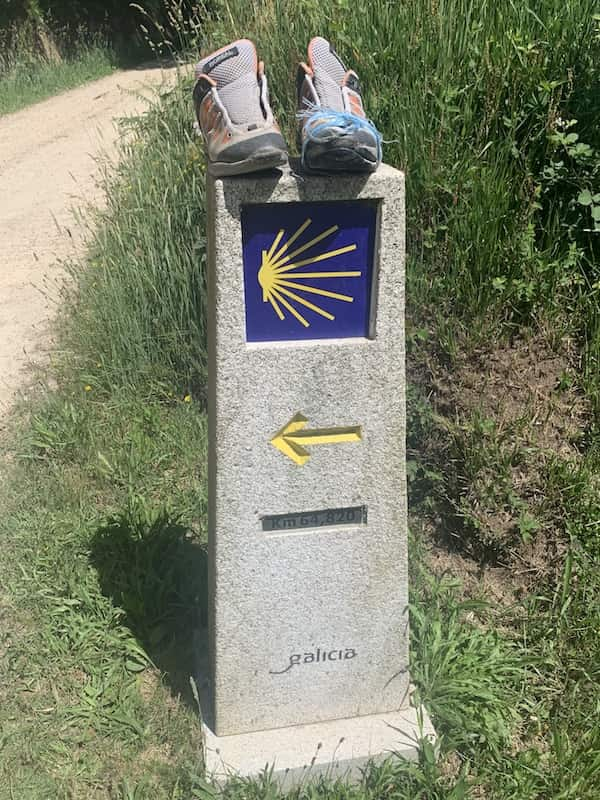
THE ULTIMATE GUIDE TO CAMINO DE SANTIAGO
THIS POST MAY CONTAIN COMPENSATED LINKS. PLEASE READ MY DISCLAIMER FOR MORE INFO.
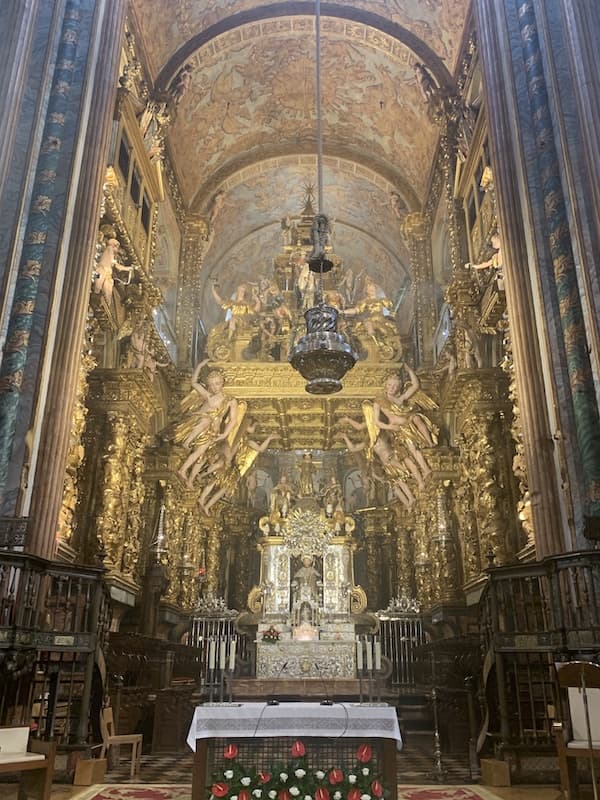
WHAT IS CAMINO DEL SANTIAGO?
Camino de Santiago means the Way of St James.
Camino is the way in Spanish, and Santiago is Saint James in Spanish.
Actually, Santiago comes from Santo Yago (Sant Iago). Yago is an old Spanish version of James.
Camino de Santiago, or St James Way, is one of the most famous long-distance hiking and pilgrimage routes.
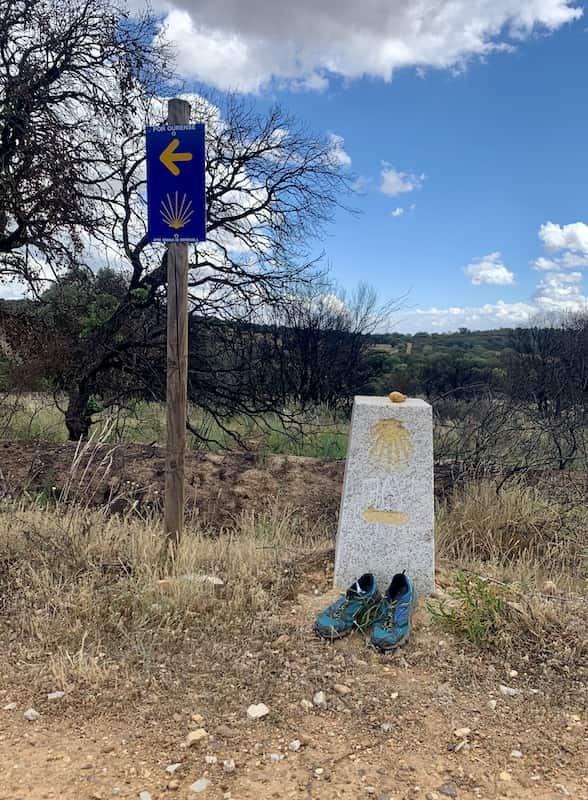
What is the Way of St James?
Camino de Santiago is a network of routes across Europe leading to the tomb of St James the Apostle in the Cathedral of Santiago de Compostela in the Galicia region in northwest Spain.
The Way of St James was originally an ancient Christian pilgrimage route. Over time, it became one of the most popular long-distance walking and hiking routes in the world overall.
In addition, UNESCO recognized the importance and universal value of the Camino and declared the Camino a World Heritage Site.
To conclude, the Camino de Santiago is a famous pilgrimage, long-distance trekking, and hiking trail of enormous cultural significance.
WHO WAS ST JAMES?
St James the Apostle, or Santiago in Spanish, was one of the Twelve Apostles of Jesus Christ. St James is the saint patron of Spain.
St James, the Apostle (also called St James the Greater), was a brother of St John the Apostle and one of the most devoted disciples of Jesus Christ. St James the Apostle and his brother St John the Apostle were among the first disciples of Jesus Christ.
They were fishermen along with Peter and Andrew on the Sea of Galilee when Jesus Christ asked them to follow Him and to become ‘fishermen of men’.
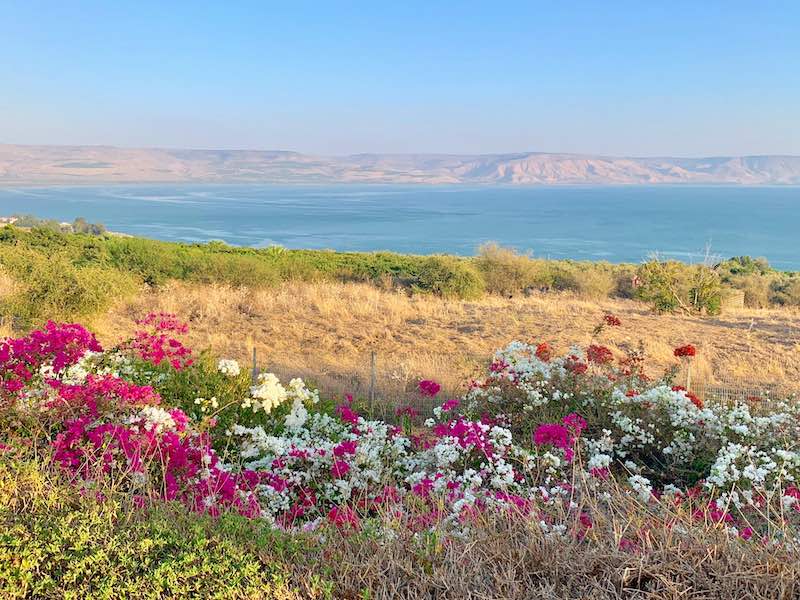
St James the Apostle was one of the closest disciples of Jesus Christ. St James the Apostle witnessed the Transfiguration of Jesus on Mount Tabor and the agony of Jesus in the Garden of Gethsemane.
Saint James spread Christianity on the Iberian peninsula for almost forty years in the first years of the new era.
His remains are in a tomb in the Cathedral in Santiago de Compostela in Galicia, Spain.
St James, or Santiago, is the saint patron of Spain.
The feast day of St James is July 25.
SANTIAGO DE COMPOSTELA
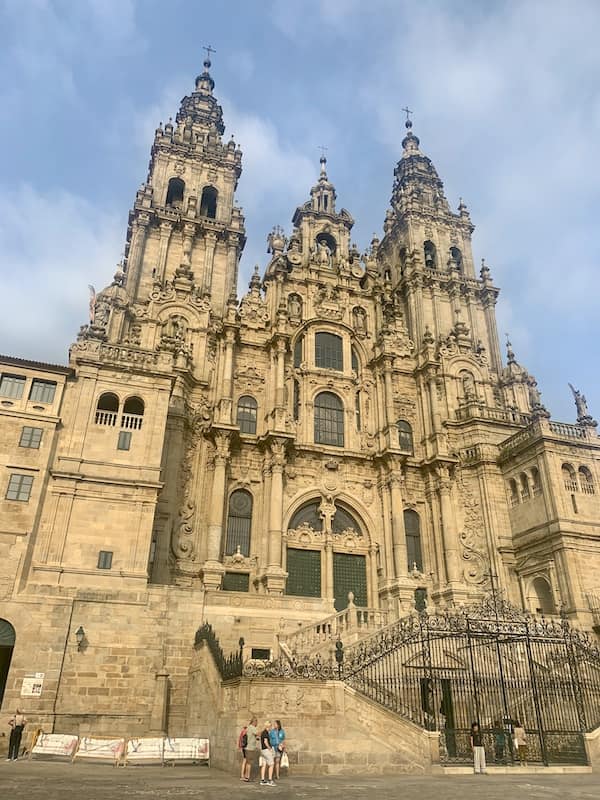
Jerusalem, Rome, and Santiago are the three most important Christian pilgrimage sites.
Camino de Santiago de Compostela in Spain is one of the most important Christian pilgrimage routes (along with Via Francigena to Rome and pilgrimage to Jerusalem).
Remains of St James were miraculously found on the shores of the Galician coast in Spain and were buried in Santiago de Compostela, Spain. His remains rest in a tomb in Santiago Cathedral.
The Way of St James has been one of the most famous Christian pilgrimage routes for over 1000 years.
CAMINO DE SANTIAGO ROUTES
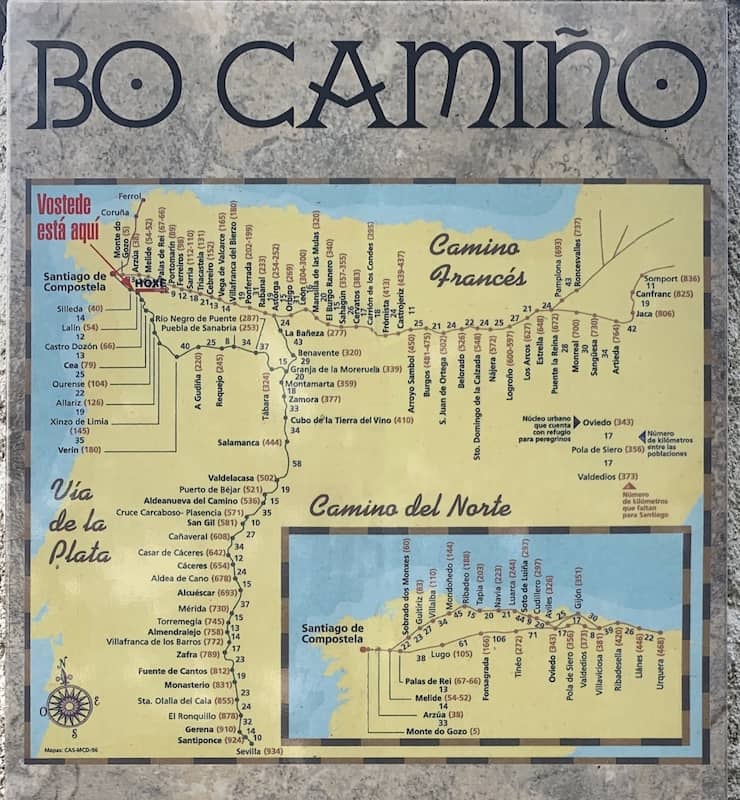
There is no single Camino de Santiago route. The Way of St James is a network of routes.
All Camino routes lead to the same place – the tomb of St James the Apostle (St James the Greater) in the Cathedral of Santiago in Spain.
The most popular Camino de Santiago routes are:
- Camino Frances (the French Way)
- Camino Portugues Central (the Central Portuguese Way)
- Camino Portugues da Costa (the Coastal Portugues Way)
- Camino del Norte (the Northern Way)
- Camino Primitivo (the Original Way)
- Camino Ingles (the English Way)
- Camino Via de La Plata (the Silver Way)
- Caminos Mozarabe starts in Almeria, Malaga, and Jean (the Mozarabic Ways)
- Camino Sanabres (the Sanabres Way)
- Camino Invienro (the Winter Way)
WHERE DOES THE CAMINO DE SANTIAGO START?
Since Camino de Santiago refers to various routes, it starts in different places depending on the Camino route.
The starting points of the most popular Camino routes are:
- Camino Frances starts in Saint-Jean-Pied-de-Port in the Basque Country, France (French Basque Country)
- Camino Portugues Central starts in Lisbon Portugal
- Camino Portugues da Costa starts in Porto in Portugal
- Camino del Norte starts in Irun in the Basque Country, Spain (Spanish Basque Country)
- Camino Primitivo starts in Ovideo in Asturias, Spain
- Camino Ingles starts in Ferrol in Galicia, Spain
- Camino Via de La Plata starts in Seville in Andalusia, Spain
- Camino Mozarabe starts in Almeria, Malaga and Jean in Andalusia, Spain
- Camino Sanabres starts in Ourense in Galicia, Spain
- Camino Invierno starts in Ponferrada in Castilla and Leon, Spain
WHERE DOES THE CAMINO DE SANTIAGO END?
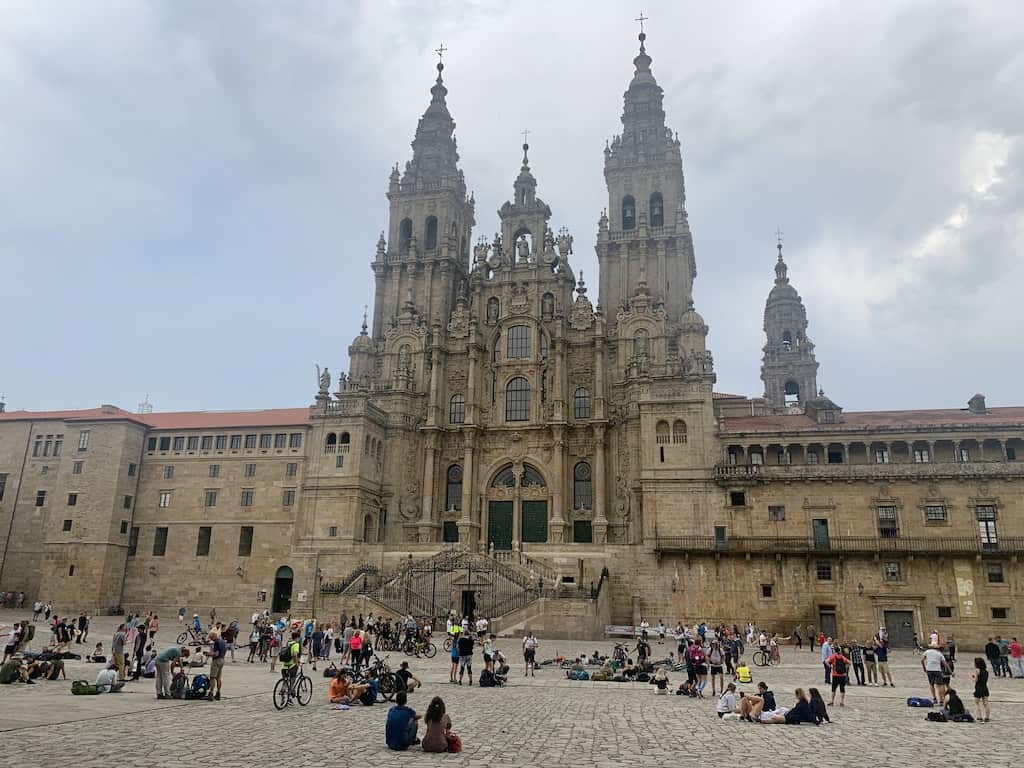
The Camino de Santiago officially ends at Obrigado Square (Plaza del Obradoiro), the square in front of the Cathedral of Santiago de Compostela, and the main square of Santiago.
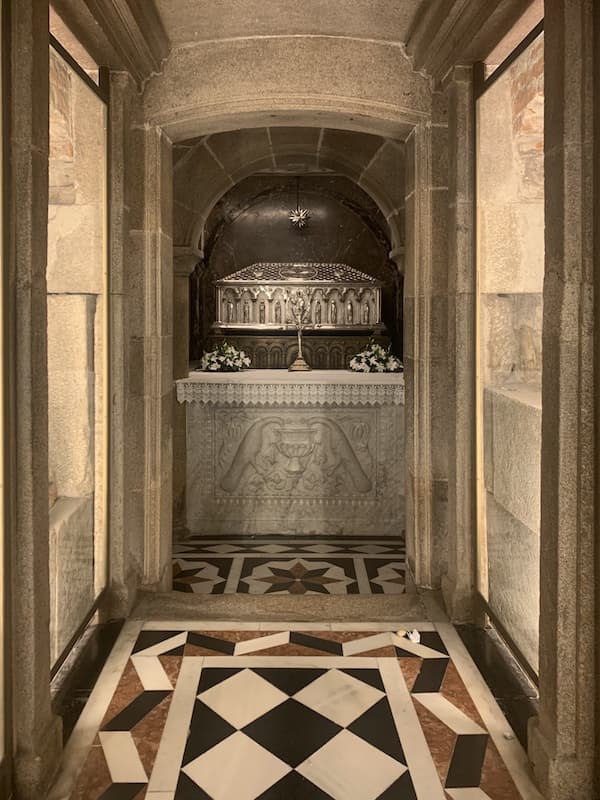
But if you are a faithful who embarks on a pilgrimage to Santiago de Compostela, the Camino ends at the tomb of St James in Santiago Cathedral.
BEST CAMINO DE SANTIAGO ROUTE
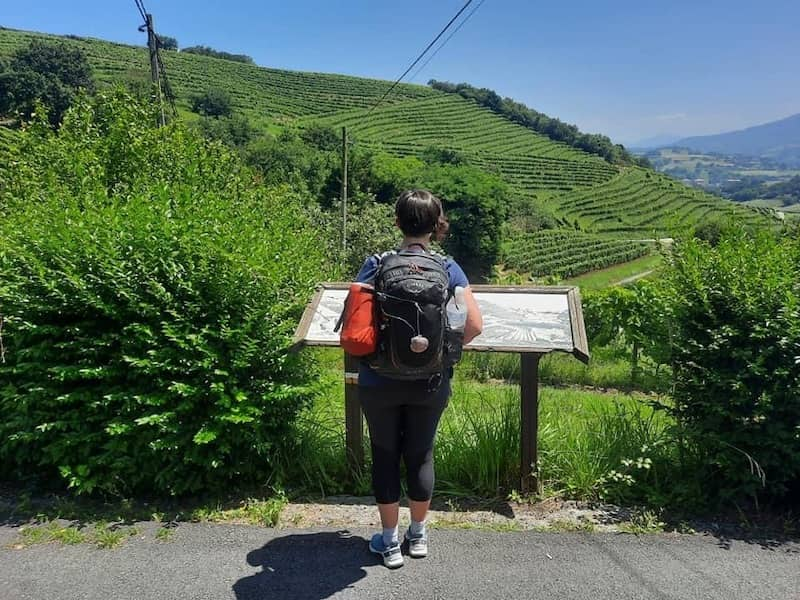
It’s hard to say which Camino de Santiago route is the best, as people have different needs and preferences.
Camino de Santiago routes differ in the difficulty of the walking and hiking terrain, length, landscapes, history, and popularity.
The most popular Camino de Santiago route is Camino Frances.
The shortest Camino de Santiago route is Camino Ingles.
The longest Camino de Santiago route is Camino Mozarabe.
The most beautiful Camino de Santiago route is Camino del Norte.
The most challenging Camino de Santiago route overall is Via de la Plata.
The most demanding Camino de Santiago route for hiking is Camino Primitivo.
To find more details about each route, read Popular Camino de Santiago routes
CAMINO DE SANTIAGO HISTORY
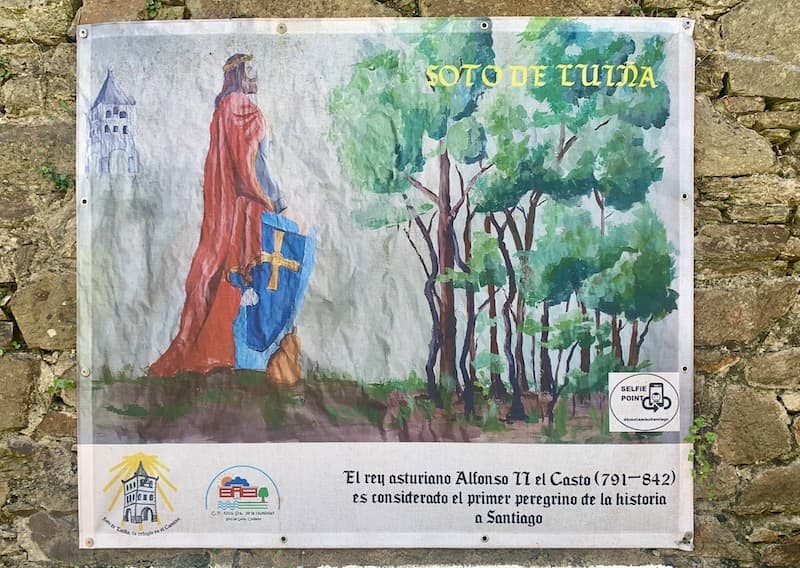
Saint James (Santiago) brought Christianity to the Iberian peninsula in the first years of the new era.
After spreading Christianity in Spain, he returned to Judea and was beheaded in Jerusalem.
However, the body of St James covered with scallop shells was miraculously found on the shores of the Atlantic coast in Galicia. His remains were moved and buried in the cathedral of Santiago de Compostela in Galicia.
The tomb of Saint James was unknown for centuries. The tomb was discovered in the 9th century.
King Alfonso II of Asturias made the first pilgrimage to Santiago in the 9th century. He took the Camino Primitivo route from Oviedo to Santiago.
King Alfonso II of Asturias was the person who ordered the building of a small chapel for hosting the remains of St James. This small chapel became what we know today as the stunning Cathedral of Santiago.
CAMINO DE SANTIAGO AND HOLY YEAR
The year when St James Day (which is on July 25) falls on Sunday is a Holy Year (Jubilee Year, Jacobean Year, or Xacobeo).
If a faithful person takes a Camino de Santiago pilgrimage during a Holy Year, they can get a plenary indulgence (forgiveness of all sins).
There are three requirements for getting a plenary indulgence:
- Visiting the tomb of St James in the Cathedral of Santiago
- Saying a prayer for the Pope’s intentions
- Making a confession and communion at least 15 days before or after visiting the Santiago Cathedral
There are two recommendations also:
- To attend a pilgrim mass at the Santiago Cathedral
- To go through the Holy Door of the Santiago Cathedral (the doors are open only on the Holy Year)
A Jacobean Year (Ano Xacobeo) happens every 6, 5, 6, and 11 years.
2021 was a Jacobean Year (that Pope extended to 2022 because of the pandemic).
The next Jacobean Year will be 2027.
The next Jacobean Years are also 2032, 2038, and 2049.
CAMINO DE SANTIAGO SIGNPOSTING
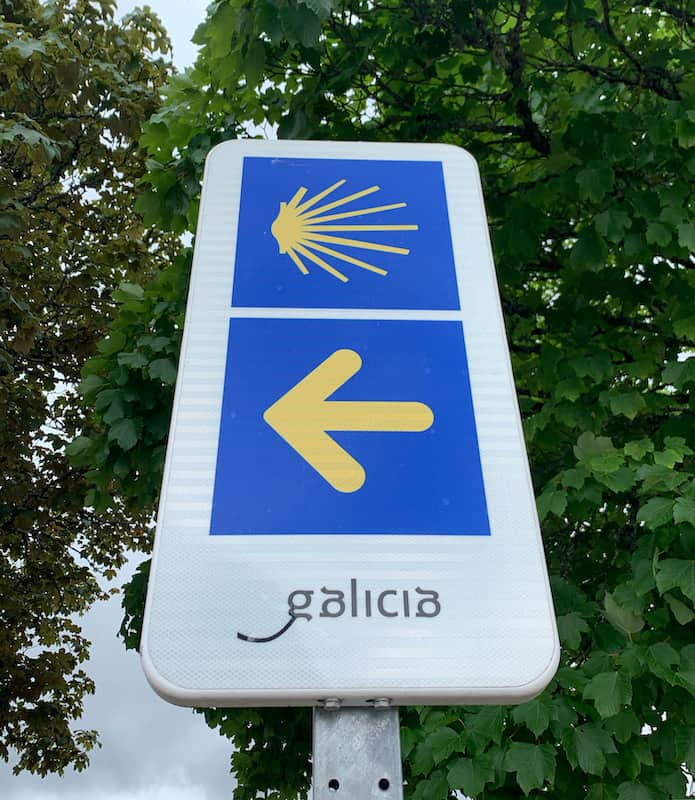
Camino de Santiago routes are well-marked and belong among the best-marked world trails.
Yellow arrows and scallops are standard way-markers of Camino de Santiago Spain.
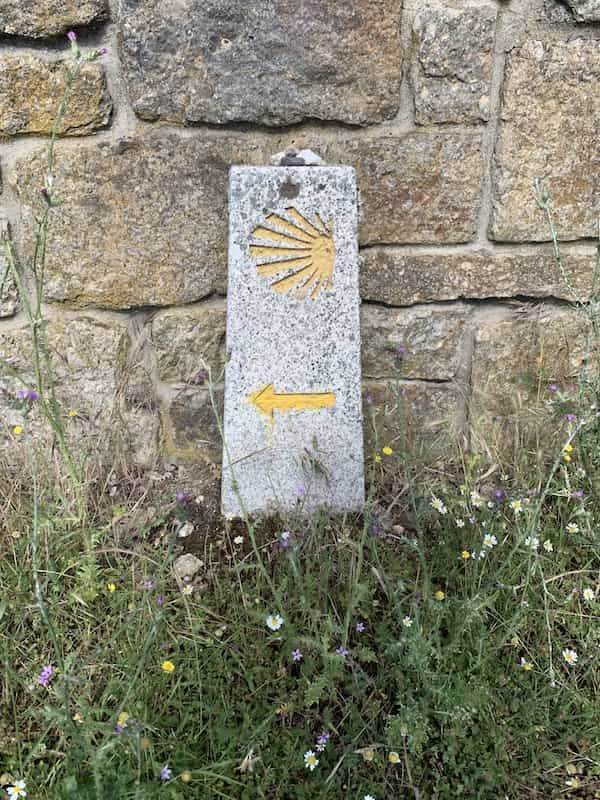
But, some Camino de Santiago routes have their unique way-markers, along with traditional Camino de Santiago signs.
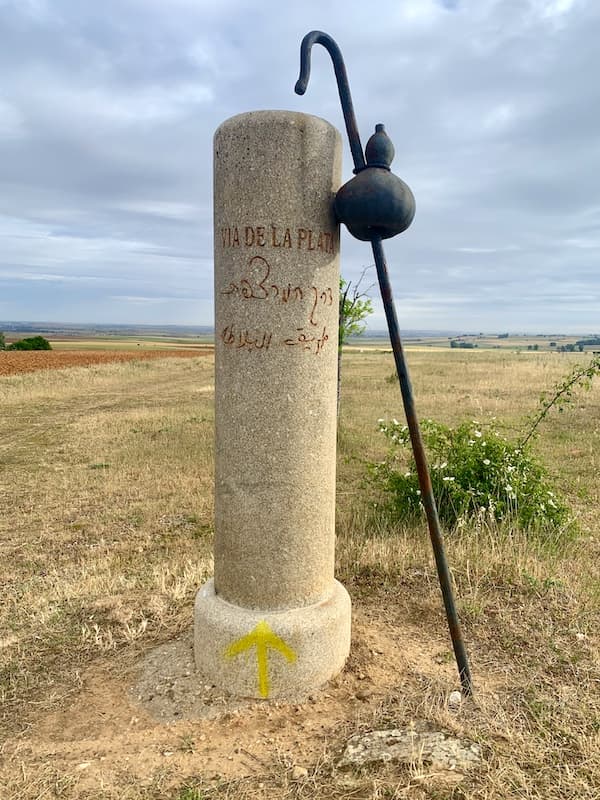
For example, Camino Via de la Plata has pillars with the carved name of the Via de La Plata in Latin and Arabic (mirroring the turbulent history of that part of Spain).
Camino Sanabres has some outstanding stone way markers carved by a famous Galician sculptor.
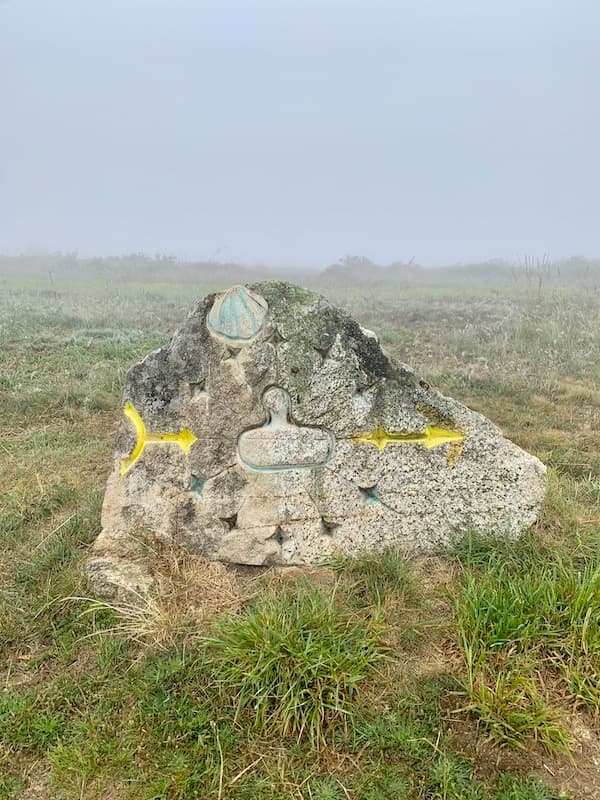
Yellow arrows and shell symbols are standard Camino markers pointing in the direction of Santiago de Compostela.
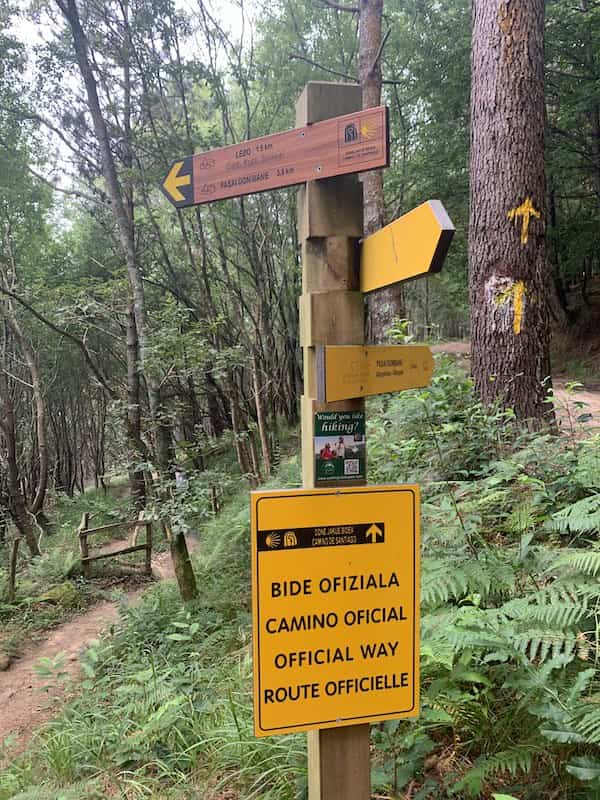
These Camino pointers can be on the ground, pavements, trees, and buildings along the Camino de Santiago routes.
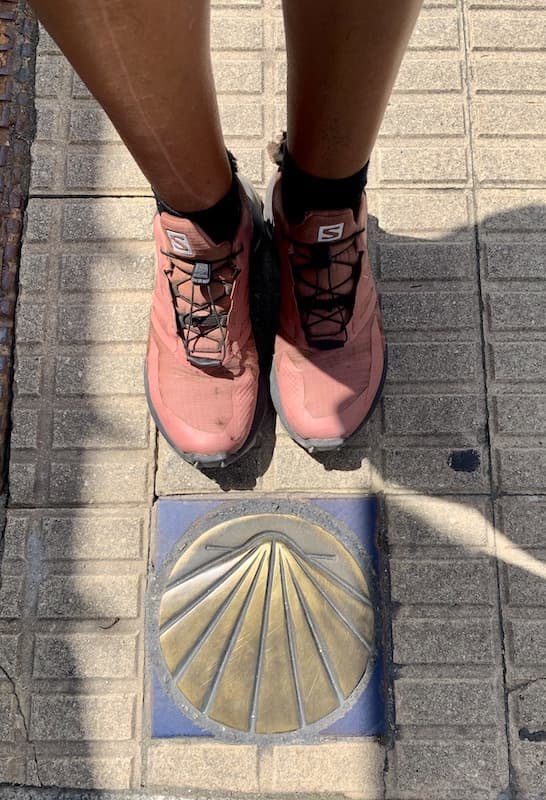
The Camino scallop shell was a sign of the completion of the Camino in medieval times.
The coast of Galicia has scallop shells in abundance. And when pilgrims reached ‘the End of the World’ (Camino a Finisterre), they took a scallop shell with them as proof of finishing the Camino.
Gradually, the scallop shell became a Camino badge. Modern pilgrims usually get their scallop shells at the beginning of the journey and put them on their backpacks as a symbol of their pilgrimage.
CAMINO DE SANTIAGO APP
There are several great Camino apps.
And Camino Ninja App is one of them.
I used Camino Ninja App on Camino de Santiago Via de la Plata, Camino Sanabres and Camino de Fisterra. I highly recommend the app as a valuable resource for hiking the Caminos.
Camino Ninja App is a free mobile phone app with offline GPS tracker maps of various Camino routes.
The app tracks your steps along the route.
A Camino pilgrim can check on the app whether they are on the correct path or not at any moment.
Camino Ninja App offers not only Camino de Santiago maps. But, also info on accommodations, available bars, restaurants, and groceries. And, even data on the elevation of the stages.
This app is a fantastic tool for planning the Caminos.
Camino Ninja App offers Camino de Santiago maps for Camino Frances, Camino Portugues Central, Camino Portugues da Costa, Camino a Fisterra, Camino a Muxia, Camino San Salvador, Camino Primitivo, Via de la Plata, Camino Sanabres, Camino Ingles.
However, if you would like to hike the Camino del Norte or any other Camino de Santiago routes not mentioned above, the Buen Camino app is a good choice. The Buen Camino app is also free to download.
CAMINO DE SANTIAGO DOCUMENTS
There are two most important Camino documents: the Pilgrim’s passport (Credential) and the Certificate of the Completion of Camino de Santiago (Compostela).
1. Pilgrim’s passport
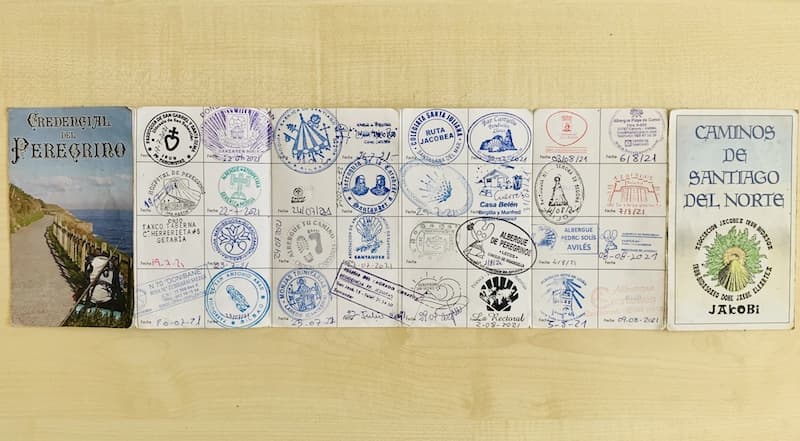
The Pilgrim’s Credential is a pilgrim passport that documents the dates and places visited on the Camino de Santiago trail. The sealed stamps record places and the dates.
The sealed stamps serve as proof of a pilgrimage journey.
Pilgrims can get Camino stamps in accommodations, bars, restaurants, churches, and tourist offices along the Camino route.
Pilgrims need to have a stamp for each stage (day) of their Camino journey on their passports to get a Compostela.
Only pilgrims with Credentials can sleep in public hostels for pilgrims ((albergues de peregrinos). But, some private hostels don’t ask for Credentials.
Where to get a Camino Credential?
Credentials are available in larger municipal albergues, churches, and parishes in the major towns and cities along the Camino and at national Camino associations.
If you would like to get your Credential before starting walking Camino de Santiago, check it out with your national Camino association in advance.
2. Compostela
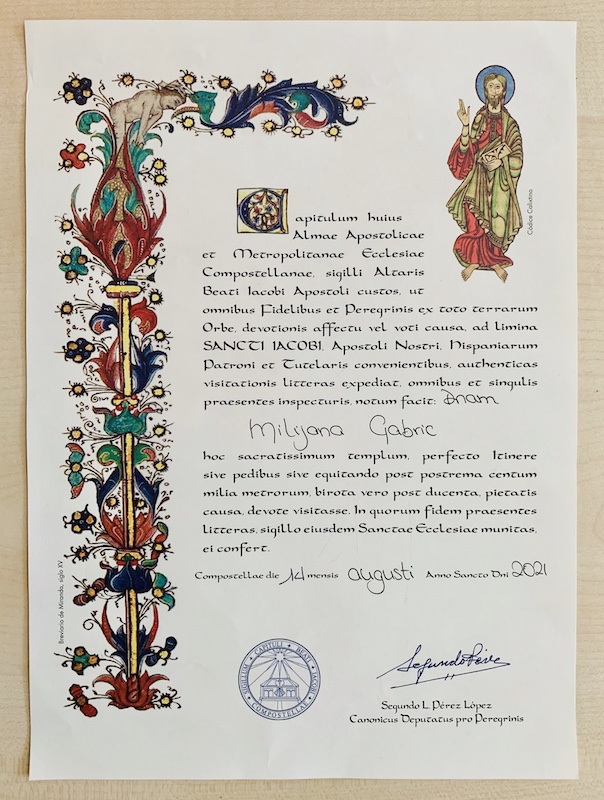
The Compostela is the official certificate (document) that testifies to finishing the Camino de Santiago pilgrimage.
Pilgrim has to show their Pilgrim’s Credential (Pilgrim’s Passport) to get their Compostela certificate.
The Pilgrim’s Reception Office in Santiago de Compostela issues the Compostela certificate.
Requirements for getting the Compostela certificate:
Pilgrims who traveled on foot or horseback the last 100 km (62 mi) of any Camino route to Santiago de Compostela, or who traveled by bicycle the last 200 km (124 mi) of any route to Santiago de Compostela are eligible for getting the Camino certificate.
3. Pilgrim’s Distance Certificate

Along with Compostela, there is a Distance Certificate. It should be requested. The Distance Certificate shows the distance a pilgrim has walked to Santiago.
Where to get a Compostela and Distance Certificate?
Pilgrim’s Reception Office in Santiago de Compostela issues Compostela and Distance Certificates.
Address: Rúa das Carretas, 33, 15705 Santiago de Compostela, Spain
Working hours: 9-19 every day
BOTAFUMEIRO
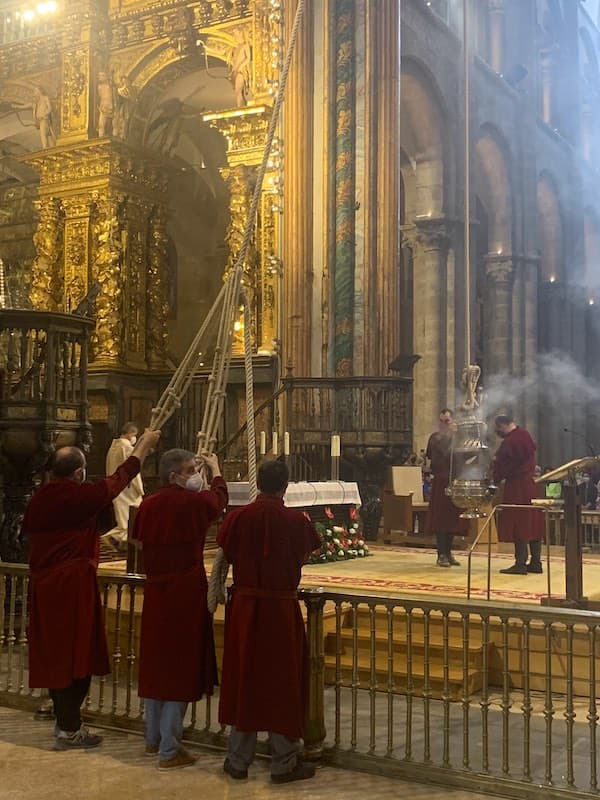
Botafumerio of Santiago Cathedral is probably the most famous incense burner in the world.
The Santiago de Compostela Botafumeiro weighs around 50 kg and is 1.60 m tall. As such, it is one of the largest thuribles in the world.
The first mention of Santiago’s Botafumeiro dates back to the 14th-century Codex Calixtinus where this famous censer was called Turibulum Magnum.
Santiago’s Boatafumeiro is always swung on the next holidays:
- The Epiphany (January 6)
- Resurrection Sunday
- The Apparition of the Apostle-Clavijo (May 23)
- Pentecost
- The Martyrdom of Saint James (July 25)
- The Assumption of Mary (August 15)
- All Saints (November 1)
- Christ the King
- The Immaculate Conception (December 8)
- Christmas (December 25)
- Transfer of the remains of the Apostle (December 30)
Santiago’s Botafumeiro swings on holy masses for pilgrims. Holy mass for pilgrims is traditionally held at noon in the Cathedral. During the Holy Year, there are more holy masses in a day, and Santiago’s incense burner is swung more frequently (because of the larger number of pilgrims who arrive at the Cathedral).
CAMINO DE SANTIAGO PACKING
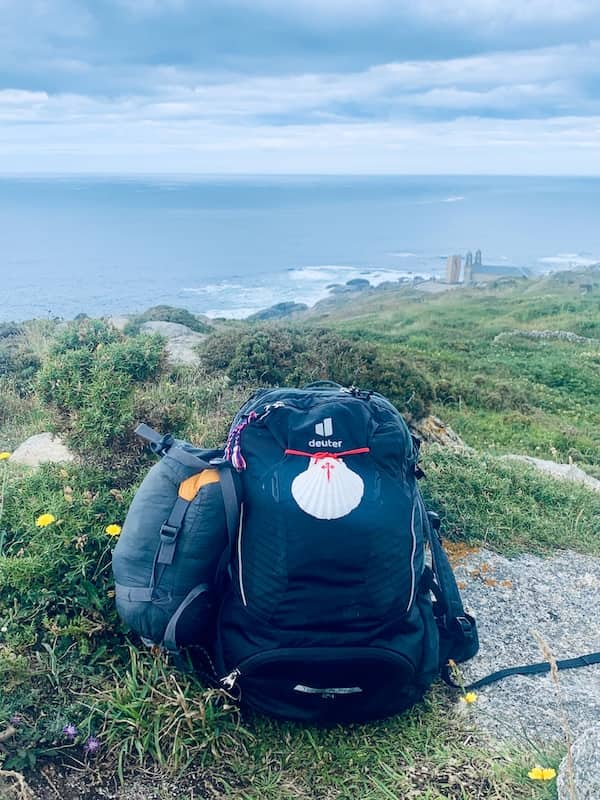
Camino routes go through villages, towns, and some big cities.
The places along Camino de Santiago frequently have shops, stores, and pharmacies.
Thus, there’s no need to overpack and pack anything but essentials for the Camino de Santiago hike.
I hiked Camino del Norte in the summer of 2021, Via de la Plata (via Camino Sanabres), and Santiago Fisterra in June 2022, with the same items.
Read my Camino de Santiago packing list, which I recommend wholeheartedly!
CAMINO DE SANTIAGO ACCOMMODATION
Camino pilgrims can sleep in municipal pilgrim hostels (albergues de peregrinos), private hostels (for pilgrims and tourists), tourist hostels, and hotels in bigger towns along the Camino de Santiago trail.
However, only pilgrims with the Credentials can sleep in public hostels for pilgrims (albergues de peregrinos) as they are considered Camino pilgrims.
It’s worth mentioning that some municipal pilgrims’ hostels and even some private pilgrims’ hostels are donations (you give money if you want and how much you want).
Municipal hostels for pilgrims have bunk bends with disposable bed sheets and pillows. A sleeping bag is a must-have for sleeping in municipal hostels. Most of the municipal albergues have a kitchen with a microwave and some basic eating utensils, as many pilgrims cook for themselves in the hostels. Municipal hostels often have washing and drying machines for clothing.
CAMINO DE SANTIAGO COSTS
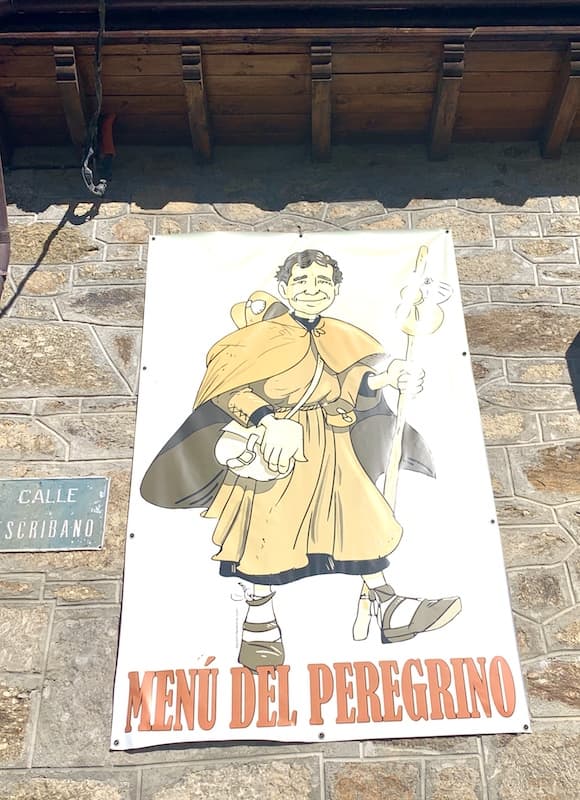
An average Camino de Santiago pilgrim spends between 1.000,00 € and 1.500,00 € for a month of walking the Camino de Santiago. Pilgrim’s daily budget averages between 20 € and 30 €.
The Camino budget depends on two main factors:
- the places a pilgrim sleeps in – whether they sleep in public or private pilgrims’ hostels, tourists’ or pilgrims’ hostels, guest houses, B&Bs, or hotels,
- the food and places where they eat – whether they eat a daily pilgrim menu of 11 EURO, buy food in grocery stores and supermarkets, or eat at gourmand restaurants along the route. (Try the Galician-style Pedron peppers and scallops in Galicia! They are some of the most popular Spanish food!)
Average Camino prices:
- Municipal hostel for pilgrims: 8 €
- Private hostel: 10-15 €
- Coffee: 2 €
- Typical Spanish breakfast
(coffee + toasted bread with grated tomatoes, or toasted bread with jam and butter + juice): 4 € - Pilgrims menu: 11 €
- Washing machine: 3 €
- Drying machine: 3 €
BEST TIME TO WALK CAMINO DE SANTIAGO
The best time to walk Camino de Santiago, in general, is summer.
All Camino facilities (pilgrims hostels, bars, restaurants) are open in summer, especially on the famous Camino Frances.
Still, there are some exceptions.
For instance, Via de La Plata goes through the regions of Andalusia and Extremadura in southern Spain known for the extreme heat in summer. Unfortunately, these extreme weather conditions can have fatal consequences for pilgrims. Hiking Camino de la Plata is not recommended in summer but during spring and autumn.
The most popular time to hike Camino Frances is in summer. The Camino Frances is the most crowded at that time. Therefore, the best time to walk Camino Frances is from May to June and September to avoid crowds and enjoy pleasant weather.
The best time to walk Camino Portugues central is from May to June and September too (since it can be hot and crowded on Camino Portugues in July and August, while wet weather starts in mid-October). The same goes for Camino Portugues da Costa.
The best time to walk the Camino del Norte is July and August (It is the peak of summer with the lowest chance of rain since the Camino del Norte route goes along the rainy northern Spain coast).
The best time to walk Camino Ingles is from mid-March to November.
The best time to walk Camino Sanabres is from April to June and September to October.
The best time to walk Camino Primitivo is from June to September, the time of the year with the lowest chance of rain.
The best time to walk Camino Mozarabe is during spring and autumn (to avoid the extreme heat in summer). The best seasons to walk Camino Invierno are spring and autumn.
The best time to walk Camino a Finistere is from April to June and from September to October. The same is the best time to walk Camino a Muxia.
RELATED READ:
How long is Camino de Santiago?
FAQ
What does Camino mean?
Camino means ‘Way’. Camino de Santiago means ‘Way to Santiago’. Camino de Compostela means ‘Way to Compostela’.
What does Buen Camino mean?
Buen Camino means ‘Good Journey’. Buen Camino is a greeting wishing ‘good journey’ to a pilgrim.
How much does the Camino de Santiago cost?
Pilgrim’s daily budget averages between 20 € and 30 €.
An average Camino de Santiago pilgrim spends between 1.000,00 € and 1.500,00 € for 30 days of walking the Camino de Santiago.
- This Hidden Corner of Italy Will Steal Your Heart – Here are The Best Things to Do in Puglia Italy! - April 11, 2025
- Want to Meet the Pope? Here’s How to Get Your Audience with the Pope Tickets! - April 7, 2025
- Visiting the Vatican: Ultimate Itinerary, Best Vatican Tours, and Pro Tips You Can’t Miss! - April 2, 2025


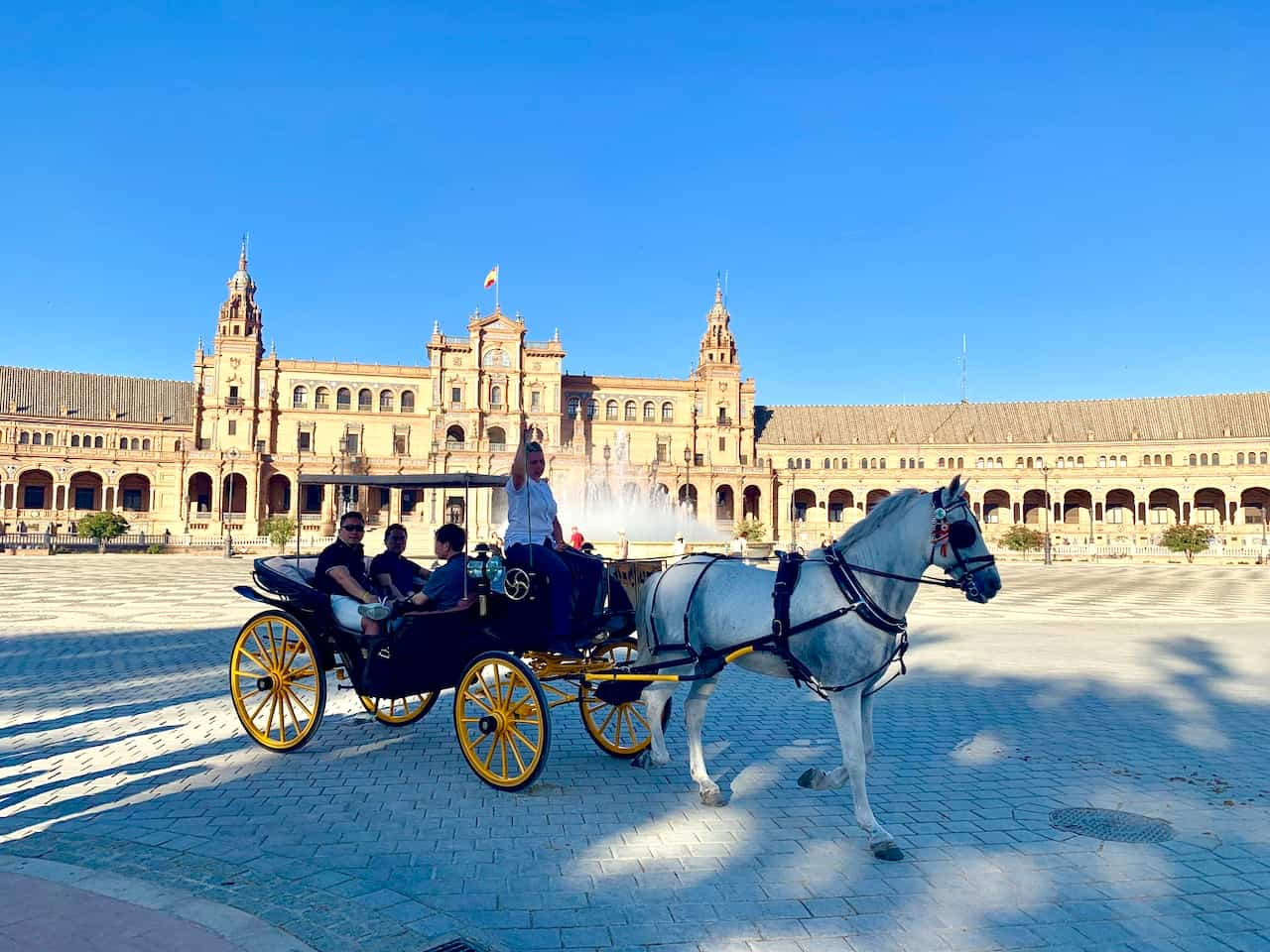
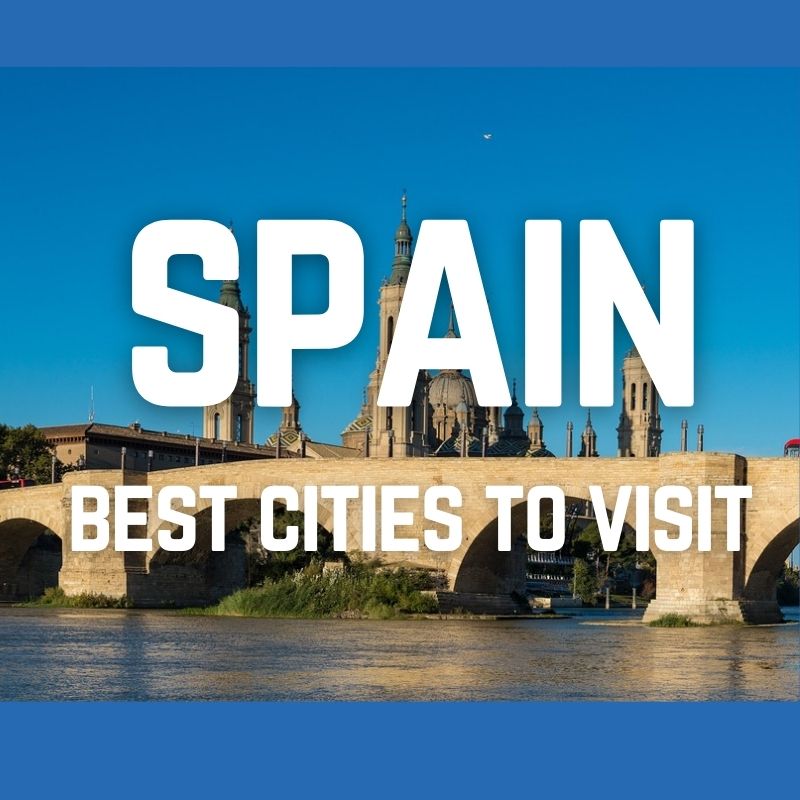
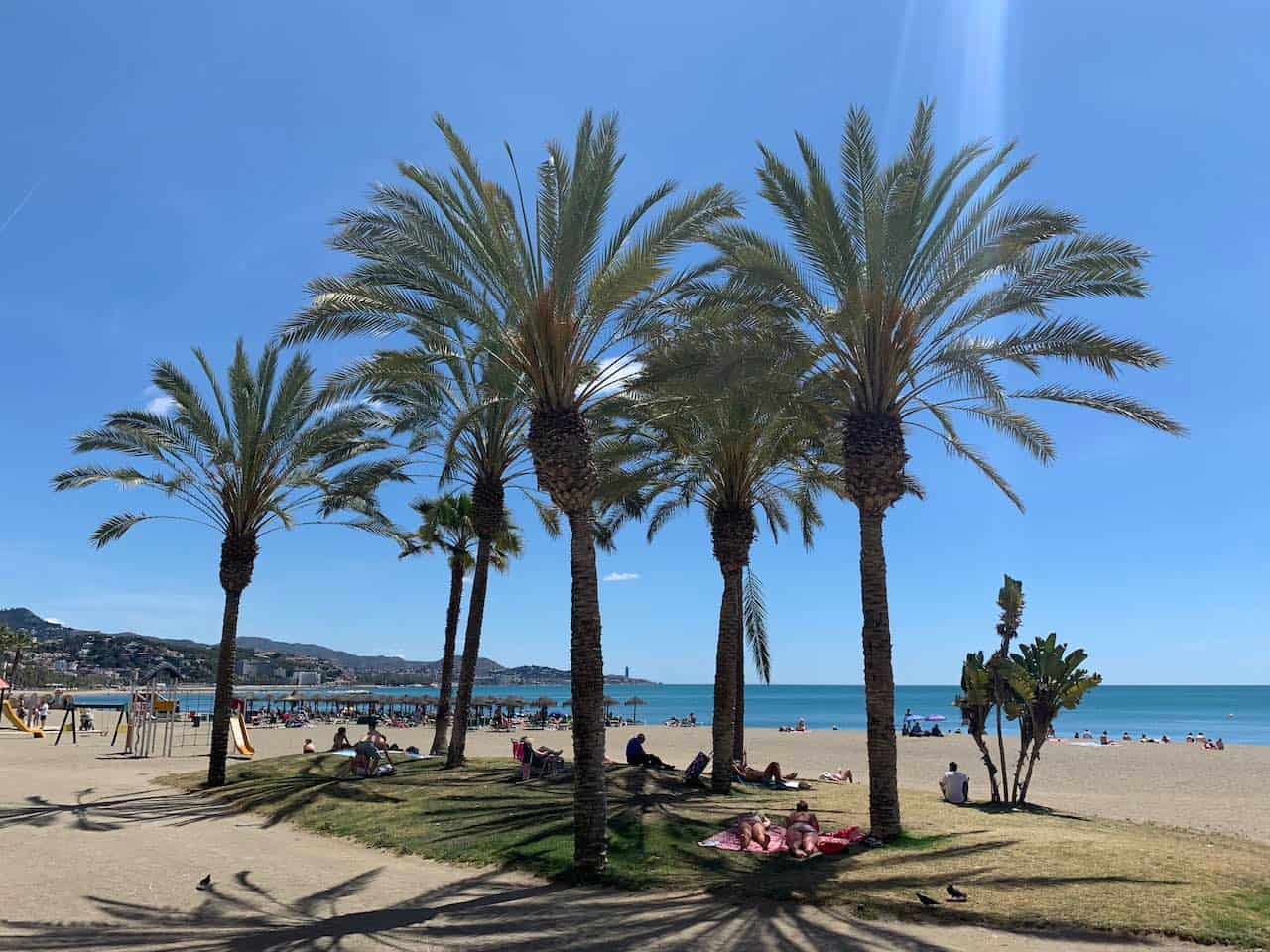
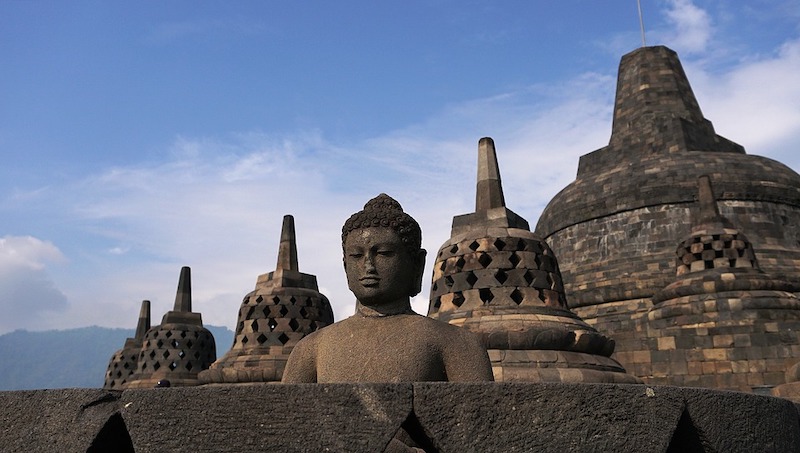
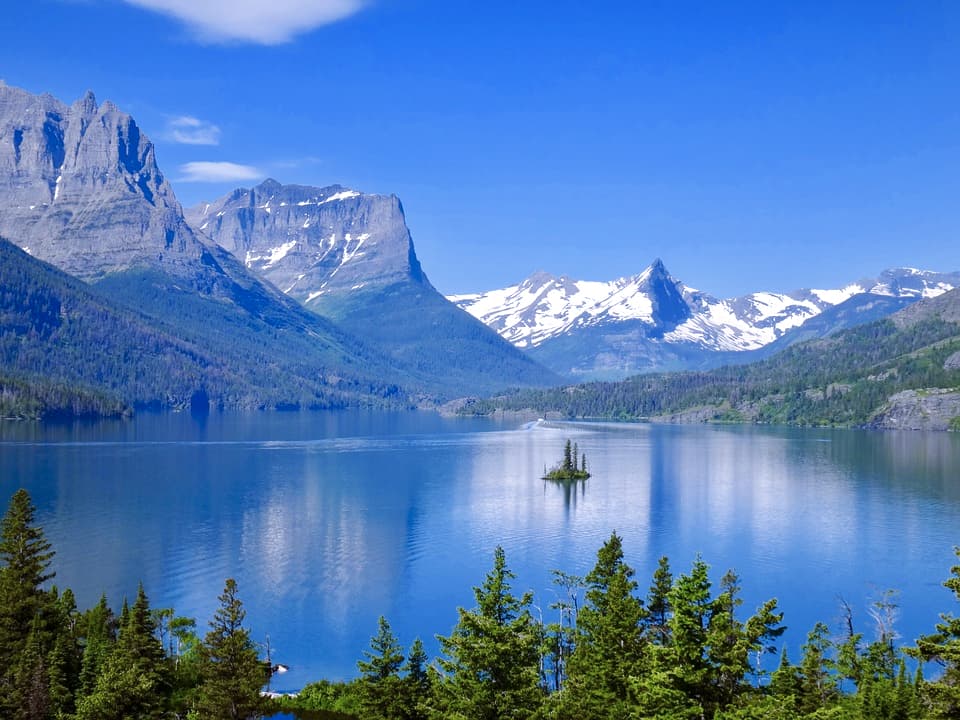
Have you read FOOTFALLS, Poems of the Camino by Suzanne Doerge?
It captured with great human insight the
Beauty of the trek
Hi Judy!
Thanks for reading my blog.
I have never heard of Footfalls before.
But, thanks for your recommendation. It sounds interesting. I am adding it to my reading list now.
Best, Milijana
Would we be able to find accommodations on the way without reservation? Probably Portuguese from Tui or French way in June this year
Hi Susan!
Pilgrims hostels (Albergue de Peregrinos) can’t be booked in advance. They work ‘first come, first served’. Pilgrims hostels are exclusively for pilgrims with credentials (pilgrims passports).
However, there are also tourist hostels and B&Bs in villages and hotels in the towns along the routes.
The Frech Way and Portugues Way are the most popular Camino routes. They can be crowded in June.
But, because they are so popular, the French Way and Portuguese Way have many facilities (hostels, guesthouses, B&Bs, bars, restaurants, etc).
So, I believe you will be fine without booking anything in advance.
Buen Camino!
Milijana